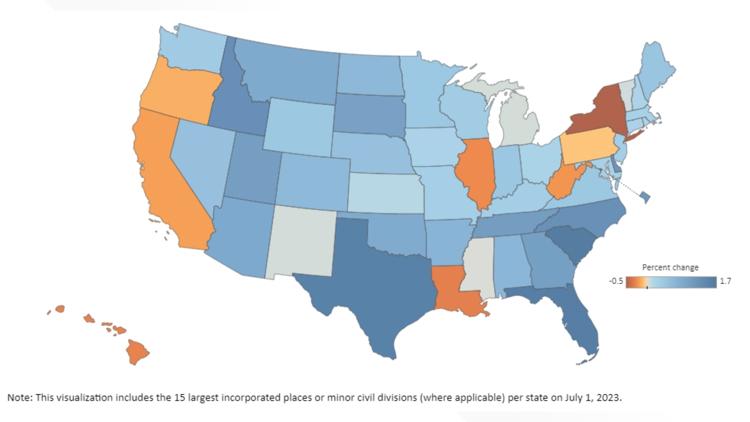DENVER — Out of Colorado's largest metropolitan areas, a few saw their population either remain the same or even decrease last year, according to data released Thursday by the U.S. Census Bureau.
The state's population as a whole increased 0.6% between July 1, 2022, and July 1, 2023, to a total of 5,877,610 people, the data shows. That's a slight jump from the year prior, when Colorado saw an increase of 0.5%.
As for Colorado's 15 largest metropolitan areas, here are the percentage differences in population and the number of residents as of July 1, 2023:
- Arvada: No percentage change, 121,414
- Aurora: 0.3%, 395,052
- Boulder: 0.3%, 105,898
- Castle Rock: 1.6%, 81,415
- Centennial: 0.9%, 106,883
- Colorado Springs: 0.5%, 488,664
- Denver: 0.4%, 716,577
- Fort Collins: 0.2%, 170,376
- Greeley: 3.1%, 112,609
- Lakewood: No percentage change, 155,961
- Longmont: -0.2% (decline), 98,630
- Loveland: 1.9%, 79,352
- Pueblo: -0.3% (decline), 111,077
- Thornton: 1.2%, 144,922
- Westminster: 0.1%, 114,875
In the rest of the U.S., modest reversals of population declines were seen in large cities in the nation's Northeast and Midwest, while the census estimates showed 13 of the 15 fastest-growing cities in the U.S. were in the South — eight in Texas alone.
San Antonio, Texas, had the biggest growth spurt in pure numbers last year, adding about 22,000 residents. It was followed by other Southern cities, including Fort Worth, Texas; Charlotte, North Carolina; Jacksonville, Florida; and Port St. Lucie, Florida.
Three of the largest cities in the U.S. that had been bleeding residents this decade stanched those departures somewhat. New York City, which has lost almost 550,000 residents this decade so far, saw a drop of only 77,000 residents last year, about three-fifths the numbers from the previous year.
Los Angeles lost only 1,800 people last year, following a decline in the 2020s of almost 78,000 residents. Chicago, which has lost almost 82,000 people this decade, only had a population drop of 8,200 residents last year.
And San Francisco, which has lost a greater share of residents this decade than any other big city — almost 7.5% — actually grew by more than 1,200 residents last year.
Detroit, Michigan’s largest city, had seen an exodus of people since the 1950s. Yet the estimates released Thursday show Detroit's population rose by 1,852 people from 631,366 in 2022 to 633,218 last year.
It's a milestone for Detroit, which had 1.8 million residents in the 1950s only to see its population dwindle and then plummet through suburban white flight, a 1967 race riot, the migration to the suburbs by many of the Black middle class and the national economic downturn that foreshadowed the city's 2013 bankruptcy filing.
More 9NEWS Colorado coverage:
SUGGESTED VIDEOS: Latest from 9NEWS
9NEWS+ has multiple live daily shows including 9NEWS Mornings, Next with Kyle Clark and 9NEWS+ Daily, an original streaming program. 9NEWS+ is where you can watch live breaking news, weather updates, and press conferences. You can also replay recent newscasts and find videos on demand of our top stories, local politics, investigations and Colorado specific features.
To download 9NEWS+ on Roku search for KUSA.
To download 9NEWS+ on Fire TV search for 9NEWS.



